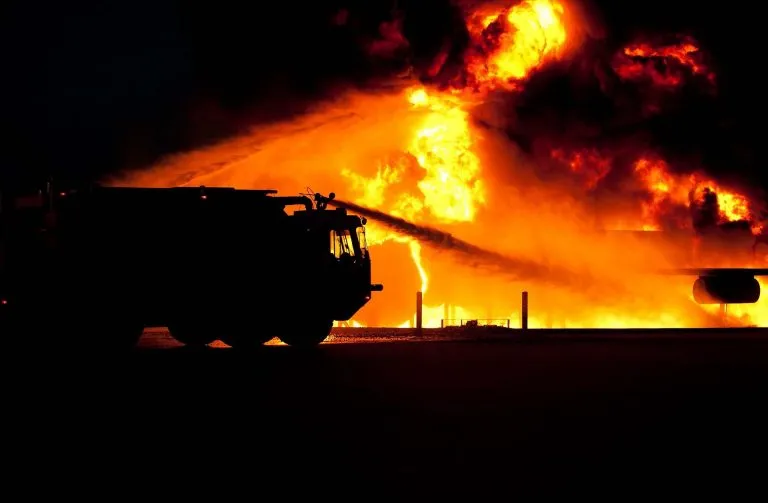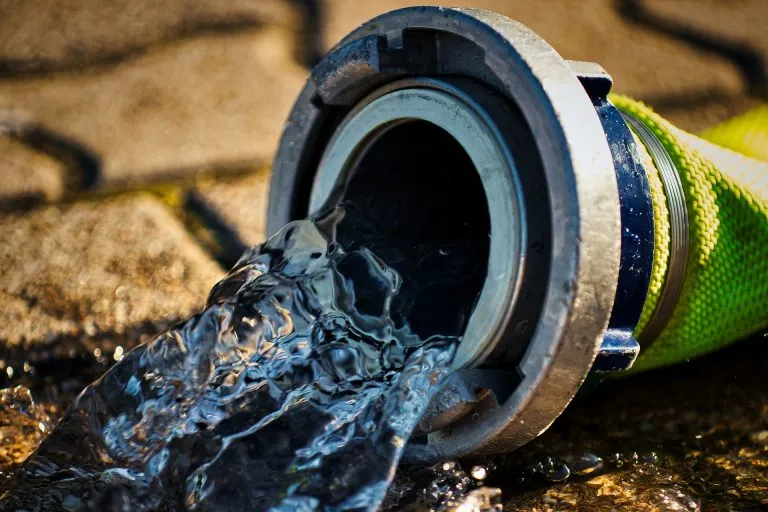Fire hazards severely threaten society, the marketplace, and even the forest. Electrical faults, smoking materials, flammable gases, and combustible materials typically cause fire hazards. Therefore, no matter what size business or industry you run, you must know the importance of fire hoses. It is also essential to properly understand how these fire hoses ensure your safety.
This article will provide a comprehensive guide on everything about fire hoses. It will cover the fundamentals and different types of fire hoses. In addition, it will also highlight their various uses. The end of this article will provide expert advice on selecting and maintaining fire hoses.

What is A Fire Hose?
A fire hose is a specialized hydraulic hose that transports water or other extinguishing material to a fire hazard. It is an essential tool for firefighters, buildings, apartments, and many public infrastructures. Since the 1670s, the world has continued developing the quality of these fire hoses. Various firefighter hoses are available in the market based on their different use. A typical fire hose usually consists of five other components.
- The hose jacket is the outermost component that protects the hose from abrasions, punctures, and other damage. The typical materials for manufacturing these hoses are nylon, polyester, or synthetic rubber.
- Reinforcement: It is the most crucial component of a fire hose. It provides the structural support to the hose. In addition, it can withstand high pressure generated by water or other extinguishing agents. It is made of synthetic fibers such as polyester or nylon.
- The inner tube is the innermost layer of a fire hose. It carries water or other extinguishing agents to the fire source. However, it is made of rubber or thermoplastic materials. They can withstand exposure to heat, chemicals, and other environmental factors.
- Fire hose couplings are typically metal fittings connected to other hoses or a fire hydrant. They are made from different materials, such as aluminum or brass. However, this component is naturally strong, durable, and corrosion-resistant.
- Nozzles are the final component that can be found at the end of the hose. It controls the flow of water. It also contributes to the dispersion of the water in a specific pattern.
How Does A Fire Hose Work?
In the previous section, we have learned five primary components of a fire hose. These components deliver water or other extinguishing agents to the fire hazard site. The nozzle at the end of the hose disperses the water in a specific pattern. Some of these nozzles are typically narrow and capable of providing a high-pressure water stream. On the other hand, some nozzles create a spray pattern capable of covering a larger area. The firefighters can adjust this component based on the distance and severity of the fire.
The couplings connected to the fire hydrant typically start the process. After that, the inner tube carries the stream of water to the nozzle. In this case, multiple couplings may attach two or more fire hoses for longer distances. Finally, the water reaches the nozzle, and firefighters can adjust the volume and direction per the requirements.
The role of water pressure in a fire hose is immense. The critical factor of fire hose effectiveness is the pressure of water flowing through the hose. Firefighter hoses generally can withstand high pressure ranging from 150 psi (1MPa) to 300 psi (2Mpa). This pressure is typically generated by a pump that draws water from the hydrant to the fire hazard site.
Advantages And Limitations of Fire Hoses
Firefighter hoses are an essential tool that provides quick and efficient water delivery. However, like other tools, firefighter hoses also have some advantages and limitations. This section will discuss some of their primary benefits and limitations. The advantages of using fire hoses include:
- High water flow rates: Fire hoses are designed to provide high-pressure water streams. The exact pressure is necessary to extinguish flame to prevent fire spread. As mentioned, a typical fire hose can withstand pressure up to 2 MPa.
- Long-reach capabilities: Fire hoses can cover longer distances in emergencies. Some buildings, apartments, or marketplaces may require longer hoses from the outdoor hydrants. As a result, fire hoses are incredibly suitable for those who need to access fires in hard-to-hard areas or on the upper floors of buildings.
- Flexibility and versatility: Fire hoses are suitable in various situations and environments. As a result, they become versatile tools for firefighters.
Although fire hoses provide many benefits for extinguishing fires, they have some limitations. Some of their drawbacks include:
- Heavyweight and size: Fire hoses are heavier than other hydraulic hoses, especially when charged with water.
- Limited maneuverability: Fire hoses require a certain amount of space when charged with water. As a result, it is sometimes more challenging in crowded or confined areas.
- Require professionals: Working with fire hoses requires a certain level of expertise. Specialized training and regular maintenance ensure safety and effectiveness.
Types of Fire Hoses

Firefighter hoses come in different types and sizes for various application purposes. Understanding these types will help you choose the best fire hose for your application. As a result, you can ensure that you have the necessary tools for emergencies. However, in the following, we will discuss the five most common types of fire hoses.
#1 Attack Hose
Attack hoses are high-pressure hoses that carry water or other extinguishing agent to a fire hazard site. It is the most common type of fire hose used in firefighting. However, these firefighter hoses are lightweight and easy to maneuver. As a result, firefighters can quickly position them and deliver water to the fire site. Attack hose is made of synthetic materials, such as nylon. They come in various diameters, ranging from 1 inch to 3 inches.
#2 Supply And Relay Hose
These firefighter hoses are more prominent in diameter than attack hoses carrying water from a distant hydrant to the fire pumper. It may also relay water from one pump to another over a long distance. The average diameter ranges from 3 inches to 5 inches. However, these fire hoses are made of rubber or vinyl. Supply and relay hoses are prevalent in industrial or commercial settings.
#3 Suction Hose
These firefighter hoses are also popular as hard-suction hoses. Suction hoses are typically rubber-covered with metal reinforcements. However, these fire hoses draw water from a nearby source to the fire hazard site. Suction hoses are also larger in diameter than attack hoses. The nominal diameter ranges from 2.5 inches to 6.0 inches. The standard length of the suction hose pipe is 10 ft, approximately 3 meters.
#4 Forestry Hose
As the name implies, forestry hoses are ideal for rural or wildland firefighting settings. These fire hoses are also made of synthetic materials, such as nylon. They come in different sizes ranging from 1 inch to 1.5 inches. However, the forestry hose is portable and easy to deploy. As a result, it allows firefighters to respond to fires in remote areas quickly.
#5 Booster Hose
Booster line hoses provide an additional source of water pressure for firefighting settings. You may find these fire hoses in conjunction with other fire hoses. However, booster hoses can increase the flow rate of water to the fire hazard site. These hoses also come in different diameters ranging from 0.75 inches to 1 inch.
Different Uses of Fire Hoses
The five common types of fire hoses discussed above depend on the hose’s specific use and application. This section will discuss two primary uses of these hoses. It will also mention the type of fire hoses required for each use.
Suction
Suction is one of the most critical steps for firefighters. It involves suction hoses to draw water from a water source into the fire engine’s pump. The water sources can be a fire hydrant, pool, or even tank. The suction process may require two different suction hoses for specific use.
- Partially embedded suction hoses: These fire hoses are typically used for shallow water sources. In this situation, you should partially bury the hose to ensure stable suction. These fire hoses have a wire helix that maintains their shape. These helix patterns also prevent the hoses from collapsing under suction.
- Fully embedded suction hoses: If the water source is deep, then fully embedded suction hoses are ideal. These hoses need to be fully buried to prevent moving around. However, these hoses are stronger and more durable than partially embedded suction hoses. These hoses can also withstand harsh conditions.
Delivery
After the water reaches the pump, the pump then transfers this water to the nozzle. Therefore, these fire hoses are designed to transport water from the fire engine’s pump to the nozzle. Like hydraulic suction hoses, delivery hoses also have two different types.
- Percolating delivery hose: These hoses usually cover a large area with water, such as in forest fires. These hoses contain tiny pores in the outer jacket. These pores allow water to seep through. As a result, it creates a spray effect.
- Non-percolating delivery hose: These hoses are usually used for focused targets. They provide a high-pressure water jet to extinguish a fire. These hoses don’t have tiny pores. As a result, it prevents water from seeping through. Finally, it creases a strong and focused water stream.
Expert Advice
Fire hoses are crucial in extinguishing all fire hazards. Therefore, choosing the right ones is necessary to ensure effective operation. In this case, the type of fire hoses you choose depends on the specific demands of the situation. For this, you can consider the following three primary points:
- Fire types
- Required water pressure
- Covering distances
However, regular maintenance and inspection are also necessary to ensure the reliability and longevity of a fire hose. In this case, you can follow the steps below:
- Checking for any damage, wear, and tear
- Proper storage and handling
- Follow the manufacturer’s guidelines
Above all, proper training and maintenance are essential for effective and safe use of a fire hose. However, if you still have questions regarding any hoses, contact us. Rentone Hose keeps one of the best teams of experts in the customer section. They can help you with answering all the questions you have.
